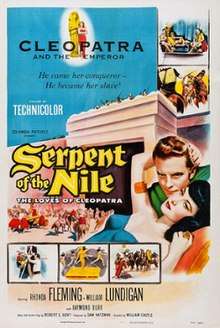Serpent of the Nile
| Serpent of the Nile | |
|---|---|
 | |
| Directed by | William Castle |
| Produced by | Sam Katzman |
| Written by | Robert E. Kent |
| Starring |
Rhonda Fleming William Lundigan Raymond Burr |
| Narrated by | Fred F. Sears |
| Music by | Mischa Bakaleinikoff |
| Cinematography | Henry Freulich |
| Edited by | Gene Havlick |
| Distributed by | Columbia Pictures |
Release date | 8 May 1953 |
Running time | 81 minutes |
| Country | United States |
| Language | English |
Serpent of the Nile is a 1953 Technicolor historical adventure film produced by Sam Katzman and directed by William Castle. The film starred Rhonda Fleming, Raymond Burr, William Lundigan and Michael Ansara. In an early role, actress Julie Newmar (listed as Julie Newmeyer) appears as an exotic dancer clad only in gold paint (and a gold fabric bikini of early 1950s style).[1]
Plot
The film opens in 44 BC, just after the assassination of Julius Caesar, and tells the story of the Egyptian Queen Cleopatra (Fleming) and her relationship with the Roman general Mark Anthony (Burr) from that time until their mutual suicide in 30 BC. It also stars William Lundigan as Lucilius and Michael Fox as Octavius. Lucilius, having previously accompanied Julius Caesar to Egypt and having been a close witness to Caesar's romance with Cleopatra, believes that Cleopatra is a woman highly skilled in besotting men to promote her own agenda, in this case to bind Mark Anthony to her desire to become queen of Rome and to make her son by Caesar the eventual ruler of the Roman Empire. In the meantime, as Lucilius becomes aware, Cleopatra is beguiling Anthony with continuous showings of feasting and luxury while the vast population of Egypt is suffering in hunger and poverty. When Lucilius reveals his concerns to Cleopatra, she makes an unsuccessful attempt to seduce him, in order to win him to her side. Cleopatra persuades Anthony that all this disaffection is the work of her younger half-sister, Arsinoe, and Lucilius is sent on an expedition against her in which she is (unhistorically) killed. Lucilius returns from this trip wounded by Cleopatra's own soldiers and even more distrustful of her, and is confined to his apartments as an honored prisoner, while Anthony continues to have his judgment clouded with constant feasting and drinking (and, although this is not mentioned, some sort of physical contact with Cleopatra's person). But Anthony dimly realizes that he has failed in his duties to Rome, most specifically in his role as a member of the ruling triumvirate, and that Cleopatra is scheming to use him to conquer Rome to make himself king and herself queen and Caesar's son the next absolute ruler of Rome, but he knows that Romans will never accept such a development; so he enables Lucilius to escape, with instructions to return to Rome and warn Octavius of what is happening in Egypt. (Unlike the Elizabeth Taylor version, this Cleopatra is not madly in love with Anthony, but is merely using him as a stepping stone). Soon enough Octavius brings Roman armies to Egypt to subdue this incipient mutiny. In this movie it would appear that a conscience-stricken Anthony stays in Cleopatra's palace, refusing to lead an Egyptian army against his beloved Rome. As Octavius closes in, Anthony stabs himself, Lucilius breaches the palace gates in time to bring a dying Anthony to Cleopatra's chamber, and Cleopatra, in despair of the complete frustration of her ambitions, uses a snake to kill herself. This brings the movie to its end before we see Cleopatra die.
Production
The movie was reportedly based on Cleopatra by H. Rider Haggard.[2] The title was apparently adapted from Shakespeare's Antony and Cleopatra, Act I, scene 5.
The film had a very low budget. It was shot on the sets left over from Rita Hayworth's Salome.[3] One sequence depicts a chariot racing through the sands of Egypt towards a sand dune in the distance, behind which looms a pyramid. It is extremely obvious that this composition (like many others) is a matte shot: the pyramid in the background is a superimposed painting, with the sand dune concealing the join between the live action and the matte. Elsewhere in the film, Rhonda Fleming as Cleopatra is clearly wearing a "bullet bra" of the style that was fashionable in the 1950s, and the Egyptian dancing girls are wearing bikinis of the same era.
Notes
- ↑ p.47 Dixon, Wheeler W. Lost in the Fifties: Recovering Phantom Hollywood 2005 SIU Press
- ↑ Drama: Dunne and MacMurray Reunion Hinted; Sam Katzman Slate Notable Schallert, Edwin. Los Angeles Times (1923-Current File) [Los Angeles, Calif] 21 Nov 1951: A7.
- ↑ p. 25 Parla, Paul & Mitchell, Charles P. Screen Sirens Scream!: Interviews with 20 Actresses from Science Fiction 2009 McFarland
External links